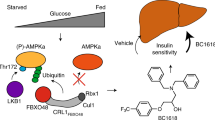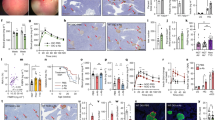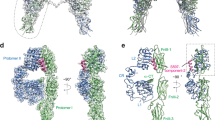Abstract
Glucokinase (GK) is a glucose-phosphorylating enzyme that regulates insulin release and hepatic metabolism, and its loss of function is implicated in diabetes pathogenesis. GK activators (GKAs) are attractive therapeutics in diabetes; however, clinical data indicate that their benefits can be offset by hypoglycemia, owing to marked allosteric enhancement of the enzyme's glucose affinity. We show that a phosphomimetic of the BCL-2 homology 3 (BH3) α-helix derived from human BAD, a GK-binding partner, increases the enzyme catalytic rate without dramatically changing glucose affinity, thus providing a new mechanism for pharmacologic activation of GK. Remarkably, BAD BH3 phosphomimetic mediates these effects by engaging a new region near the enzyme's active site. This interaction increases insulin secretion in human islets and restores the function of naturally occurring human GK mutants at the active site. Thus, BAD phosphomimetics may serve as a new class of GKAs.
This is a preview of subscription content, access via your institution
Access options
Subscribe to this journal
Receive 12 print issues and online access
$189.00 per year
only $15.75 per issue
Buy this article
- Purchase on Springer Link
- Instant access to full article PDF
Prices may be subject to local taxes which are calculated during checkout




Similar content being viewed by others
References
Ashcroft, F.M. & Rorsman, P. Diabetes mellitus and the β cell: the last ten years. Cell 148, 1160–1171 (2012).
Samuel, V.T. & Shulman, G.I. Mechanisms for insulin resistance: common threads and missing links. Cell 148, 852–871 (2012).
Majumdar, S.K. & Inzucchi, S.E. Investigational anti-hyperglycemic agents: the future of type 2 diabetes therapy? Endocrine 44, 47–58 (2013).
Grimsby, J., Berthel, S.J. & Sarabu, R. Glucokinase activators for the potential treatment of type 2 diabetes. Curr. Top. Med. Chem. 8, 1524–1532 (2008).
Matschinsky, F.M. Assessing the potential of glucokinase activators in diabetes therapy. Nat. Rev. Drug Discov. 8, 399–416 (2009).
Dadon, D. et al. Glucose metabolism: key endogenous regulator of β-cell replication and survival. Diabetes Obes. Metab. 14 (suppl. 3), 101–108 (2012).
Antoine, M., Boutin, J.A. & Ferry, G. Binding kinetics of glucose and allosteric activators to human glucokinase reveal multiple conformational states. Biochemistry 48, 5466–5482 (2009).
Davis, E.A. et al. Mutants of glucokinase cause hypoglycaemia- and hyperglycaemia syndromes and their analysis illuminates fundamental quantitative concepts of glucose homeostasis. Diabetologia 42, 1175–1186 (1999).
Grimsby, J. et al. Allosteric activators of glucokinase: potential role in diabetes therapy. Science 301, 370–373 (2003).
Kamata, K., Mitsuya, M., Nishimura, T., Eiki, J. & Nagata, Y. Structural basis for allosteric regulation of the monomeric allosteric enzyme human glucokinase. Structure 12, 429–438 (2004).
Larion, M., Salinas, R.K., Bruschweiler-Li, L., Bruschweiler, R. & Miller, B.G. Direct evidence of conformational heterogeneity in human pancreatic glucokinase from high-resolution nuclear magnetic resonance. Biochemistry 49, 7969–7971 (2010).
Liu, S. et al. Insights into mechanism of glucokinase activation: observation of multiple distinct protein conformations. J. Biol. Chem. 287, 13598–13610 (2012).
Petit, P. et al. The active conformation of human glucokinase is not altered by allosteric activators. Acta Crystallogr. D Biol. Crystallogr. 67, 929–935 (2011).
Pfefferkorn, J.A. et al. Discovery of (S)-6-(3-cyclopentyl-2-(4-(trifluoromethyl)-1H-imidazol-1-yl)propanamido)nicotinic acid as a hepatoselective glucokinase activator clinical candidate for treating type 2 diabetes mellitus. J. Med. Chem. 55, 1318–1333 (2012).
Futamura, M. et al. An allosteric activator of glucokinase impairs the interaction of glucokinase and glucokinase regulatory protein and regulates glucose metabolism. J. Biol. Chem. 281, 37668–37674 (2006).
Pfefferkorn, J.A. et al. Pyridones as glucokinase activators: identification of a unique metabolic liability of the 4-sulfonyl-2-pyridone heterocycle. Bioorg. Med. Chem. Lett. 19, 3247–3252 (2009).
Bonadonna, R.C. et al. Piragliatin (RO4389620), a novel glucokinase activator, lowers plasma glucose both in the postabsorptive state and after a glucose challenge in patients with type 2 diabetes mellitus: a mechanistic study. J. Clin. Endocrinol. Metab. 95, 5028–5036 (2010).
Ericsson, H. et al. Tolerability, pharmacokinetics, and pharmacodynamics of the glucokinase activator AZD1656, after single ascending doses in healthy subjects during euglycemic clamp. Int. J. Clin. Pharmacol. Ther. 50, 765–777 (2012).
Meininger, G.E. et al. Effects of MK-0941, a novel glucokinase activator, on glycemic control in insulin-treated patients with type 2 diabetes. Diabetes Care 34, 2560–2566 (2011).
Danial, N.N. BAD: undertaker by night, candyman by day. Oncogene 27 (suppl. 1), S53–S70 (2008).
Danial, N.N. et al. BAD and glucokinase reside in a mitochondrial complex that integrates glycolysis and apoptosis. Nature 424, 952–956 (2003).
Danial, N.N. et al. Dual role of proapoptotic BAD in insulin secretion and beta cell survival. Nat. Med. 14, 144–153 (2008).
Liu, S. et al. Insulin signaling regulates mitochondrial function in pancreatic β-cells. PLoS ONE 4, e7983 (2009).
Gavathiotis, E. et al. BAX activation is initiated at a novel interaction site. Nature 455, 1076–1081 (2008).
LaBelle, J.L. et al. A stapled BIM peptide overcomes apoptotic resistance in hematologic cancers. J. Clin. Invest. 122, 2018–2031 (2012).
Leshchiner, E.S., Braun, C.R., Bird, G.H. & Walensky, L.D. Direct activation of full-length proapoptotic BAK. Proc. Natl. Acad. Sci. USA 110, E986–E995 (2013).
Bebernitz, G.R. et al. Investigation of functionally liver selective glucokinase activators for the treatment of type 2 diabetes. J. Med. Chem. 52, 6142–6152 (2009).
Brocklehurst, K.J. et al. Stimulation of hepatocyte glucose metabolism by novel small molecule glucokinase activators. Diabetes 53, 535–541 (2004).
Castelhano, A.L. et al. Glucokinase-activating ureas. Bioorg. Med. Chem. Lett. 15, 1501–1504 (2005).
Efanov, A.M. et al. A novel glucokinase activator modulates pancreatic islet and hepatocyte function. Endocrinology 146, 3696–3701 (2005).
Fyfe, M.C. et al. Glucokinase activator PSN-GK1 displays enhanced antihyperglycaemic and insulinotropic actions. Diabetologia 50, 1277–1287 (2007).
Ralph, E.C., Thomson, J., Almaden, J. & Sun, S. Glucose modulation of glucokinase activation by small molecules. Biochemistry 47, 5028–5036 (2008).
Braun, C.R. et al. Photoreactive stapled BH3 peptides to dissect the BCL-2 family interactome. Chem. Biol. 17, 1325–1333 (2010).
Zelent, B. et al. Mutational analysis of allosteric activation and inhibition of glucokinase. Biochem. J. 440, 203–215 (2011).
Gidh-Jain, M. et al. Glucokinase mutations associated with non-insulin-dependent (type 2) diabetes mellitus have decreased enzymatic activity: implications for structure/function relationships. Proc. Natl. Acad. Sci. USA 90, 1932–1936 (1993).
Gloyn, A. et al. in Glucokinase and Glycemic Diseases: From the Basics to Novel Therapeutics (eds. Matschinsky, F.M. & Magnuson, M.A.) 92–109 (Karger, Basel, 2004).
Kesavan, P. et al. Structural instability of mutant β-cell glucokinase: implications for the molecular pathogenesis of maturity-onset diabetes of the young (type-2). Biochem. J. 322, 57–63 (1997).
Liang, Y. et al. Variable effects of maturity-onset-diabetes-of-youth (MODY)-associated glucokinase mutations on substrate interactions and stability of the enzyme. Biochem. J. 309, 167–173 (1995).
Osbak, K.K. et al. Update on mutations in glucokinase (GCK), which cause maturity-onset diabetes of the young, permanent neonatal diabetes, and hyperinsulinemic hypoglycemia. Hum. Mutat. 30, 1512–1526 (2009).
Cullen, K.S., Matschinsky, F.M., Agius, L. & Arden, C. Susceptibility of glucokinase-MODY mutants to inactivation by oxidative stress in pancreatic β-cells. Diabetes 60, 3175–3185 (2011).
Barrio, R. et al. Nine novel mutations in maturity-onset diabetes of the young (MODY) candidate genes in 22 Spanish families. J. Clin. Endocrinol. Metab. 87, 2532–2539 (2002).
Larion, M. & Miller, B.G. Global fit analysis of glucose binding curves reveals a minimal model for kinetic cooperativity in human glucokinase. Biochemistry 49, 8902–8911 (2010).
Lin, S.X. & Neet, K.E. Demonstration of a slow conformational change in liver glucokinase by fluorescence spectroscopy. J. Biol. Chem. 265, 9670–9675 (1990).
Molnes, J., Bjorkhaug, L., Sovik, O., Njolstad, P.R. & Flatmark, T. Catalytic activation of human glucokinase by substrate binding: residue contacts involved in the binding of D-glucose to the super-open form and conformational transitions. FEBS J. 275, 2467–2481 (2008).
Larion, M. & Miller, B.G. Homotropic allosteric regulation in monomeric mammalian glucokinase. Arch. Biochem. Biophys. 519, 103–111 (2012).
Barbetti, F. et al. Opposite clinical phenotypes of glucokinase disease: description of a novel activating mutation and contiguous inactivating mutations in human glucokinase (GCK) gene. Mol. Endocrinol. 23, 1983–1989 (2009).
Kassem, S. et al. Large islets, beta-cell proliferation, and a glucokinase mutation. N. Engl. J. Med. 362, 1348–1350 (2010).
Ferre, T., Riu, E., Franckhauser, S., Agudo, J. & Bosch, F. Long-term overexpression of glucokinase in the liver of transgenic mice leads to insulin resistance. Diabetologia 46, 1662–1668 (2003).
O'Doherty, R.M., Lehman, D.L., Telemaque-Potts, S. & Newgard, C.B. Metabolic impact of glucokinase overexpression in liver: lowering of blood glucose in fed rats is accompanied by hyperlipidemia. Diabetes 48, 2022–2027 (1999).
Peter, A. et al. Hepatic glucokinase expression is associated with lipogenesis and fatty liver in humans. J. Clin. Endocrinol. Metab. 96, E1126–E1130 (2011).
Kiyosue, A., Hayashi, N., Komori, H., Leonsson-Zachrisson, M. & Johnsson, E. Dose-ranging study with the glucokinase activator AZD1656 as monotherapy in Japanese patients with type 2 diabetes mellitus. Diabetes Obes. Metab. 15, 923–930 (2013).
Wilding, J.P., Leonsson-Zachrisson, M., Wessman, C. & Johnsson, E. Dose-ranging study with the glucokinase activator AZD1656 in patients with type 2 diabetes mellitus on metformin. Diabetes Obes. Metab. 15, 750–759 (2013).
Eng, J.K., McCormack, A.L. & Yates, J.R. An approach to correlate tandem mass spectral data of peptides with amino acid sequences in a protein database. J. Am. Soc. Mass Spectrom. 5, 976–989 (1994).
Murdoch, T.B., McGhee-Wilson, D., Shapiro, A.M. & Lakey, J.R. Methods of human islet culture for transplantation. Cell Transplant. 13, 605–617 (2004).
Barbaro, B. et al. Increased albumin concentration reduces apoptosis and improves functionality of human islets. Artif. Cells Blood Substit. Immobil. Biotechnol. 36, 74–81 (2008).
Mahdi, T. et al. Secreted frizzled-related protein 4 reduces insulin secretion and is overexpressed in type 2 diabetes. Cell Metab. 16, 625–633 (2012).
Acknowledgements
We thank K. Robertson and P. Chen for technical assistance; F. Bernal, S. Devarakonda and C. Buettger for advice on protein purification; E. Gavathiotis, A. West and R. McNally for advice on structural studies; and M. Eck, N. Gray, S. Blacklow, G. Yellen and members of the Danial and Walensky laboratories for valuable discussions. This work was supported by US National Institutes of Health grants R01DK078081 (N.N.D.) and R01GM090299 (L.D.W.), a Burroughs Wellcome Fund Career Award in Biomedical Sciences (N.N.D.), Juvenile Diabetes Research Foundation grant 17-2011-595 (N.N.D.), a Claudia Adams Barr Award in Innovative Basic Cancer Research (N.N.D.), a Stand Up to Cancer Innovative Research Grant (L.D.W.), a National Sciences and Engineering Research Council of Canada postgraduate scholarship (C.R.B.), a Swiss National Science Foundation postdoctoral fellowship (S.L.) and a Juvenile Diabetes Research Foundation postdoctoral fellowship (M.A.O.).
Author information
Authors and Affiliations
Contributions
B.S., E.P., M.A.O. and N.N.D. purified recombinant proteins and performed enzyme kinetic analyses. C.R.B., G.H.B. and L.D.W. designed, synthesized and characterized SAHB compounds. C.R.B. and L.D.W. performed cross-linking, MS and structural analyses. S.L. and N.N.D. performed analyses in human donor islets. B.S., C.R.B., L.D.W. and N.N.D. wrote the manuscript. F.M.M. provided critical advice and reviewed the manuscript.
Corresponding authors
Ethics declarations
Competing interests
L.D.W. is a consultant and member of the scientific advisory board for Aileron Therapeutics.
Integrated supplementary information
Supplementary Figure 1 Phospho-BAD BH3 peptides cross-link to GK after UV exposure in the presence or absence of glucose.
Uncropped gels related to Fig. 2a document detection of BAD SAHBA–GK crosslinked complex as visualized by western blot analysis using an anti-biotin antibody. The lower band corresponds to monomeric GK crosslinked to the BAD SAHBA compound, which was excised and subjected to MS/MS analysis.
Supplementary Figure 2 Cross-linking profile of BAD BH3 stapled peptide in the presence of glucose and RO0281675.
Spectral count frequency of BAD SAHBA (S118pS D123R F125Bpa) crosslinked along the GK protein sequence. GK residues involved in crosslinking, which were unique to that peptide (with a frequency >25%), are labeled.
Supplementary information
Supplementary Text and Figures
Supplementary Figures 1 and 2 and Supplementary Tables 1–3 (PDF 8934 kb)
Rights and permissions
About this article
Cite this article
Szlyk, B., Braun, C., Ljubicic, S. et al. A phospho-BAD BH3 helix activates glucokinase by a mechanism distinct from that of allosteric activators. Nat Struct Mol Biol 21, 36–42 (2014). https://doi.org/10.1038/nsmb.2717
Received:
Accepted:
Published:
Issue Date:
DOI: https://doi.org/10.1038/nsmb.2717
This article is cited by
-
Glycolytic enzymes in non-glycolytic web: functional analysis of the key players
Cell Biochemistry and Biophysics (2024)
-
Identification of Metastasis-Associated Genes in Cutaneous Squamous Cell Carcinoma Based on Bioinformatics Analysis and Experimental Validation
Advances in Therapy (2022)
-
A BAD portion of glucose can be good for inflamed beta cells
Nature Metabolism (2020)
-
Glucose-dependent partitioning of arginine to the urea cycle protects β-cells from inflammation
Nature Metabolism (2020)



